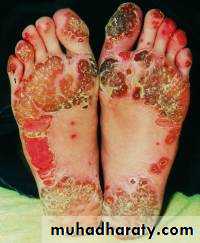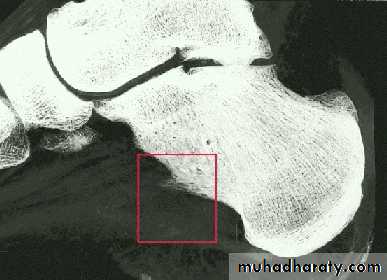RHEUMATOLOGY L-5
What does the term “seronegative” mean when applied to the term seronegative spondyloarthropathy?
a) Patients do not form antibodies
b) Patients are negative for HLA-B27
c) Patients are negative for RF
d) Patients are negative for ANA
Spondyloarthropathies
Seronegative Spondyloarthropathy: a misnomer !!thought to be variant of RA, hence “seronegative”
Definition: A group of inflammatory arthropathies that share distinctive clinical, radiographic and genetic features. These diagnoses include:
Ankylosing spondylitis
Reactive arthritis (Reiter's syndrome)
Psoriatic arthritis
Enteropathic arthritis (Crohn’s, Ulcerative colitis)
Spondyloarthropathy: several criteria have been proposed
Key Features:
Inflammatory axial arthritis (sacroiliitis and spondylitis)
Peripheral arthritis (often asymmetric and oligoarticular)
Enthesitis
HLA-B27 positivity
XRay evidence of erosions + hyperostosis (reactive bone)
Extra-axial, Extra-articular Features
Spondyloarthopathies (SpA)
Back to basics
Enthesis is the site of bony attachment ofTendon
Ligament
Cartilage
Joint capsule
Fascia
Enthesis
EtiologyThe common etiological thread of these disorders is their striking association with HLA-B27, particularly ankylosing spondylitis(AS). HLA type B27 is a finding in more than 90% of Caucasians with AS but only 8% of controls. The role of class 1 HLA antigens in the pathogenesis is supported by the fact that HLA-B27 transgenic mice spontaneously develop arthritis, skin, gut and genitourinary lesions.
What is HLA-B27?
a) It is an antibody
b) It is an MHC I molecule
c) It is an MHC II molecule
d) It is an antigen
There are clues that infections play a role, possibly by molecular mimicry, with parts of the organism which are structurally similar to the HLA molecule triggering cross-reactive antibody formation. This is unproven. AIDS is shown to increase the prevalence of reactive arthritis and spondylitis in sub-Saharan Africa even in the absence of HLA-B27. The explanation for this changing epidemiology is unclear.
The types of arthritis that fallow a precipitating infection are called reactive arthritis.
The specialized immune systems of the gut and genito-urinary mucous membranes may also play a causal role, perhaps reacting to local infections or to antigens which across the damaged mucosa.
Ankylosing Spondylitis
A type of arthritis that causes inflammation and eventually fusion of the spine and the spinal joints. Involvement of peripheral joints and extraarticular manifestations.AS causes pain, stiffness, disability, decreased spinal mobility, and decreased quality of life
The prevalence ranges from 0.1 to 1 percent of the population
Men are affected three times more than womenCommonly develops between the ages of 15 and 40
95 percent of people with AS share the genetic marker HLA-B27
CLINICAL FEATURES:--
Episodic inflammation of the sacroiliac joints in the late teenage years or early twenties is the first manifestation of AS. Pain in one or both buttocks and low back pain and stiffness are typically worse at morning and relieved by exercise. Initially the diagnosis is often missed because the patient is asymptomatic between episodes and radiological abnormalities are absent.Retention of the lumber lordosis during spinal flexion is an early sign. Later, para spinal muscle wasting develops.
The presence of three of the four fallowing indices in adult more than 50 years with chronic back pain indicate AS:-
1- morning stiffness more than 30%.
2-improvement of back pain with exercise but not rest.3-awakening because of back pain during second half of the night only.
4-alternating buttock pain.
Salient features:
1- 'question mark' posture(due to retention of lumber lordosis, fixed kyphoscoliosis of the thoracic spine with compensatory extension of the cervical spine)
2- protuberant abdomen.
Extra-articular features
1- anterior uveitis(25%)& conjunctivitis(20%)
2- prostatitis (80%) of men ; usually asymptomatic
3- cardiovascular disorders ;aortic & mitral incompetence(4% of patients who have had the disease for over 15 years), conduction defects, pericarditis4- amyloidosis
5- apical pulmonary fibrosis.
Remember:
Five 'A's of AS: apical fibrosis, anterior uveitis, aortic regurgitation, achilles tendinitis& amyloidosis.INVESTIGATION:---
-Blood :- the ESR and CRP are usually raised-HLA-testing is rarely of value because of high frequency of HLA-B27 in the population.
-X-rays:- The earliest radiological appearances in the spine are blurring of the upper or lower vertebral rims at the thoracolumbar junction(seen on lateral X-ray) caused by an enthesitis at the insertion of the intervertebral ligaments.
Sacroilitis, sclerosis, squaring of vertebrae, & bridging syndesmophytes ( marginal bony spurs that bridge the adjacent vertebral bodies) .
-MRI: demonstrates sacroiliitis before it seen on x-ray.
Bamboo spine
TREATMENT:----
--The key to the effective management of AS is early diagnosis so that a regimen of preventive exercises is started before syndesmophytes have formed. Morning exercise aims to maintain spinal motility, posture and chest expansion.--when the inflammation is active, the morning pain and stiffness are too sever to permit effective exercise , an evening dose of a long acting or slow release NSAIDs to improve sleep, pain control, and exercise compliance. Peripheral arthritis and enthesitis are managed with NSAIDs or local steroid injections.
--Methotrexate is effective for peripheral arthritis but not for spinal disease.
-- In patients with persistent, active inflammation TNF-alpha blocking drugs produce rapid, dramatic and sustained reduction of symptoms and of spinal and joint inflammation.PROGNOSIS:--
With exercise and pain relief, the prognosis is excellent and over 80% of patients are fully employed. Anti-TNF therapies are likely to reduce the morbidity of sever disease, reducing the risk of permanent spinal stiffness and progressive peripheral joint disease.Patients should be made aware that there is a risk of passing HLA-B27 gene to50% of their children. HLA-B27 positive offspring then have a 30% risk of developing AS.
In 1916, Hans Reiter reported Reiter’s syndrome: a triad of nongonococcal urethritis, conjunctivitis, and arthritis that occurred in a young German officer following an episode of bloody dysentery
Subsequently, more cases were reported following enteric infections OR venereally acquired genitourinary infections.
In 1967, the term reactive arthritis was applied to similar cases following Yersinia gastroenteritis
The two terms should be considered synonymous
The term reactive arthritis is increasingly preferred
Reactive arthritis is a sterile synovitis, which occurs fallowing an infection. Seronegative spondyloarthropathy develops in 1-2% of patients after an acute attack of dysentery, or sexually acquired infections like nonspecific urethritis in the male& nonspecific cervicitis in female. In male patients who are HLA-B27 positive, the relative risk is 30-5-%, being HLA-B27 positive is not obligatory. However, women are less commonly affected.
Reiter's syndrome is a special entity of reactive arthritis in which the fallowing triad of symptoms are found:-
-arthritis of large joints
- inflammation of the eyes in the form of conjunctivitis or uveitis and
-urethritis in male and cervicitis in women.
Reactive arthritis have been associated with all the following except:
a) Chlamydiab) Ureaplasma
c) Campylobacter
d) Gonorrhea
CLINICAL FEATURES
The onset is typically acute, with urethritis, conjunctivitis(50%)& oligoarthritis of large & small joints of lower limbs 1-3 weeks after sexual experience or bacillary dysentery.There may be systemic disturbances like weight loss, fever, & vasomotor changes in feet. The onset could be sub-acute or insidious.
There may be only asymmetric oligoarthritis with no clear preexisting urethritis or dysentery but radiological features & Achilles tendonitis are further clues.
EXRTA ARTICULAR FEATURES :
1- circinate balanitis; 20-50% , starts as vesicles rupture to form superficial erosions on the prepuce & glans penis. These lesions are painless.
2- keratoderma blenorrhagica 15%; waxy yellow –brown vesicopapules that may coalesce to form large crusty plaques. Palms, soles & scrotum are typical sites.
Chronic or recurrent disease develops in 60% of patients & not necessarily related to further infection.
KB: keratoderma
blenorrhagicumLow back pain & stiffness due to sacroiliitis can occur together with cardiac& CNS abnormalities similar to AS.
Other joints like ankles, midtarsal & MCP joints are involved in chronic reactive arthritis.
INVESTIGATIONS:
:
acute phase responses are positive, Anemia of normochromic normocytic type are clearly evident findings. Synovial fluid reveals inflammatory findings- low viscosity& turbid , with giant macrophages(Reiter's cells).
GUE for mucoid threads(urethritis), vaginal swab for Chlamydia & GSE for dysentery together with radiological changes are other clues for diagnosis.
MANAGEMENT
In the first attacks , symptomatic treatment with analgesics & NSAIDs is helpful together with intra articular steroid injections. Systemic steroids are rarely needed. In sever disease& intractable keratoderma blenorrhagica anti- rheumatic drugs like methotrexate & azathioprine are warranted.Chlamydial infections should be treated with short course tetracycline. Anterior uveitis requires systemic steroids. TNF is an inflammatory cytokine& TNF blocking agents like etanercept& infliximab have a rule in treatment of reactive arthritis.








